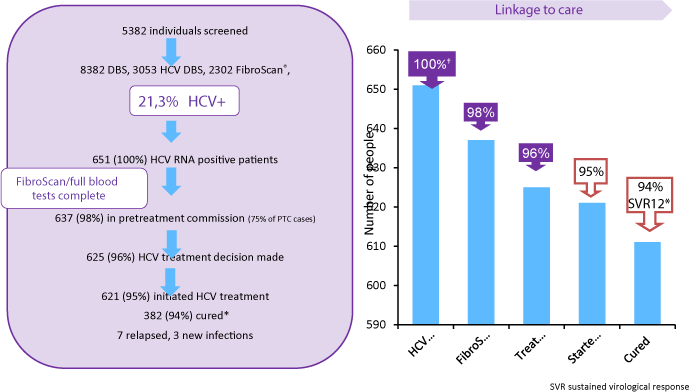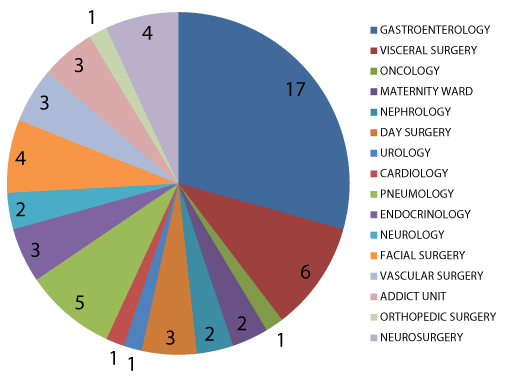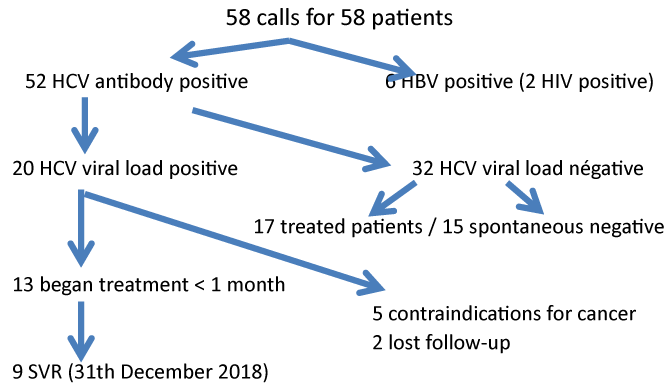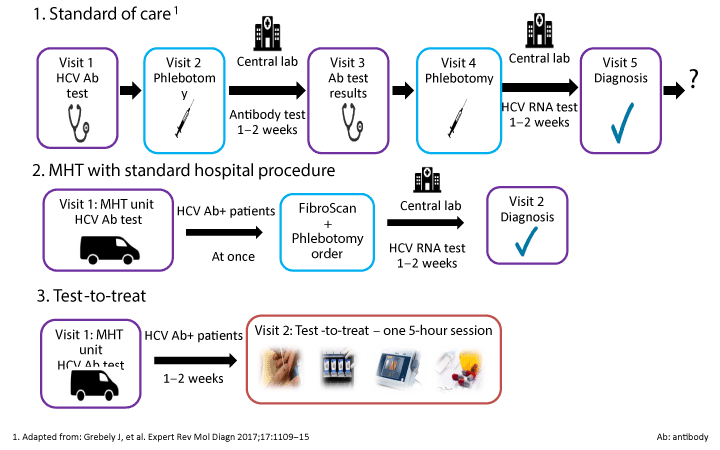Introduction: 59000 hepatitis C patients were unknown or not followed in France. In 2017, 81% of our “new” patients have already been hospitalized, especially in emergency units. Hepatitis C was noted in their file as other medical histories like appendicitis or shin fracture! Drug users came one to twelve times per year in hospital for different reasons, but never for hepatitis care. No HCV care was proposed to these patients after other health problem resolution.
Objective: To identify HCV patients coming to our hospital by using nurses of every service for a goal of zero hepatitis hospital.
Methodology: Our hepatitis specialized nurse did training sessions of nurses in every unit of our hospital about hepatitis screening, diagnosis and treatment and when to call hepatitis nurse if they had HCV positive patient and gave specific flyers and posters.
Results: In 15 months, hepatitis nurse did training sessions in 15 units of our hospital, including 92 nurses. We received 58 calls about 52 patients with hepatitis C; 50/58 patients were current or formers drug users, 32 patients are known as negative viral load, spontaneously or after antiviral treatment; 20 had positive viral load and took care by our team; 13 started immediately DAA. All drug users had also risk reduction session.
Conclusion: Hospital nurses training was easy to set up and cheap and useful to detect new patients or known patients without medical care, specially drug users. Same project could be done in every hospital.
Abbreviations
DAA: Direct Antiviral Agents; HCV: Hepatitis C Virus; MHT: Mobile Hepatitis Team; SVR: Sustained Virological Response
hepatitis C, hospital, screening
In France among 170000 patients with HCV chronic hepatitis C, 59000 patients were unknown or not followed [1]. Question to be resolved was how to find these missing patients. Mobile hepatitis team created in July 2013 took care of 651 HCV patients among 89% of current or formers drug users (Figure 1). Although highest European screening rate in France, 33% of patients didn’t take care of hepatitis C because there were not diagnosed. Drug injection was main contamination route of hepatitis C virus in France and western Europe since 1990. French guidelines were to treat all people, even inmates and drug users, even fibrosis level. Nevertheless, access of HCV screening, care and treatment in drugs users, prisoners and homeless was low in France. They were considered as difficult to treat populations. All these patients need support especially psycho-educative interventions.

Figure 1. MHT linkage to care: 2013-2018
Public hospital was a very important crossroad for population. There were 1994 different hospitals and in France for year 2017 [2], 12.2 million of people stayed at least one day, either 184 people per 1000 French residents. There were also 21 million emergencies consultations. Hospital could be missing link to find unknown HCV patients. Different ways could be used: contacting all patients who came at least one time in hepatology unit? Using data of hospitalization and consultations with specific diagnosis hepatitis B or C? Using virology laboratory data to contact patients with positive HCV or HBV viral load? All these solutions need time and many authorizations.
Hepatitis Mobile Team (HMT) was created in July 2013 to increase screening care and treatment of hepatitis B and C patients [3]. HMT was composed of one hepatologist, three nurses, one secretary, one social worker, one health care worker, for a cross-disciplinary approach. Our goal was to increase outreach screening care treatment access and cure of our target population. Target population was drugs users, prisoners, homeless, precarious people, migrants and psychiatric patients. We proposed part or all our services to our medical and social partners. There were 15 services for 42 medical and social units in half million people area. There were 4 steps: for early detection and primary prevention 1. screening by Point of Care Testing PDBS (dried blood test) for HIV HBV HCV 2. Green thread: outside POCT/DBS and FIBROSCAN** in specific converted van. 3. Outreach open center 4. Drug user’s information and prevention 5. Free blood tests in primary care for patients without social insurance 6. Staff training. For linkage to care and fibrosis assessment: 7. Social screening and diagnosis (EPICES score) 8. Mobile liver stiffness Fibroscan* (indirect measurement of liver fibrosis) in site 9. Advanced on-site specialist consultation. For access to treatment: 10. Easy access to pre-treatment commission with hepatologists, nurses, pharmacist, social worker, GP, psychiatric and/or addictologist. 11. Low cost mobile phones for patients. For follow up during and after treatment 12. Individual psycho-educative intervention sessions 13. Collective educative workshops 14. Peer to peer educational program 15. Specific one day hospitalizations. All services were free for patients and for partners. from 2013 July to 2018 December, we did 8382 DBS for 3291 people (3053 HCV DBS) and 1728 Fibroscan*. HCV new positive rate was 21.3%. Our HCV active file was 651 patients included these 21.3% new patients screened by DBS; 98% realized HCV genotype, HCV viral load and FIBROSCAN. DAA treatment was proposed to 96%; 95% started treatment, 2% were lost follow up and 3% refused treatment. After treatment, there was 7 relapse and 3 reinfections by drug injection. Our cured rate was 94%. Sociological evaluation of our program showed that 4 program qualities for patients were free access, closeness (outside hospital), speed (of the results) and availability (of nurse and social workers).
In their communication actions, MHT observed that many HCV known patients came to have information directly and, after information, started a new medical follow-up. We also made the observation in 2017 that 81% of “new” patients have already been hospitalized in our hospital, especially in emergency units. Hepatitis C was noted in their file as other medical histories like appendicitis or shin fracture! Drug users came one to twelve times per year in hospital for twelve different reasons, but never for hepatitis care. No specialized guidance was offered to them after the initial pathology was resolved. The hospital could be a specific gateway to screening and care of HCV infection.
Objective of our study was to identify HCV patients coming to our hospital by teaching and motivation nurses of every service for a goal of zero hepatitis hospital. After information from the executive and management of each unit, our hepatitis specialized nurse from MHT did training sessions of nurses in every unit of our hospital about hepatitis B and C screening, diagnosis, follow up and treatment. She insisted about importance of early diagnosis, none invasive evaluation of liver fibrosis and treatment by direct antiviral agents. The main information was “a diagnosed patient was a cured patient”. She also taught how and when calling hepatitis nurse if they had HCV or HBV positive patient. She gave specific flyers and posters to remember this project easier. Flyer of information and a poster reminiscent of the hepatitis nurse’s contact information was left in the care room. Our study began on September 2017.
From September 2017 to December 2018, hepatitis nurse did training sessions in 16 units of our hospital, including 92 nurses: 9 medicine units, 6 surgery units and maternity ward. Distribution of patient’s unit by unit was presented on figure 2. Gastroenterology, visceral surgery, pneumology and neurosurgery were most frequent units. We received 58 calls about 52 patients with hepatitis C, 1 to 4 calls per week. Fifty patients were current or formers drug users. Forty-one patients had social rights difficulties. Thirty-two patients are known as negative viral load, 17 spontaneously and 15 after antiviral treatment; 20 had positive viral load and took care by our team; 13 started immediately DAA. All drug users had also risk reduction session. Six patients have hepatitis B infection and two were also infected by HIV. Follow-up of HCV patients was detailed in figure 3. We observed quickly progressive increase of phone calls during project as the project was rolled out.

Figure 2. Distribution of calls by hospital unit

Figure 3. Follow-up of HCV patients
Our project was quickly efficient for vulnerable and out of HCV care patients. To obtain HCV eradication in 2030 is goal of WHO [4]. Simplification of HCV pathway is major possibility to test and cure patients like Grebely and our team proposed [5,6] and reported in figure 4. But before HCV treatment access, patients had to know that DAA exist and they could be treated. Too many people are under diagnosed with only one serology, no viral load measure and no liver fibrosis evaluation. In other times, HCV evaluation was done long time ago. Public hospitals were a reference place for many people, especially for vulnerable patients like psychiatric patients, migrants, drugs users or homeless. There was high prevalence of HCV infection [7].

Figure 4. Pathway simplification
Training of nursing relays within the different units of a hospital center is easy to set up and useful to orient in a specialized circuit HCV patient not previously supported, especially for drug users and homeless. Same experience could be transferable to other hospital centers and creates a dynamic zero-hepatitis hospital throughout the institution. Our goal for 2019-2020 will to develop our project in all units of our hospital specially in emergency units.
- Pioche C, Pelat C, Larsen C, Desenclos JC, Jauffret-Roustide M, et al. (2016) Estimation of hepatitis c prevalence in the general population, metropolitan France, 2011. Bull Epidemiol Hebd. 14: 224-229.
- Remy AJ, Bouchkira H, Montabone S (2016) Hepatitis Mobile Team: a new concept for benefit toward drugs users and precarious people with hepatitis C in France. AASLD Liver Congress, Boston poster. 5: 775.
- https://www.atih.sante.fr/sites/default/files/public/content/2554/atih_chiffres_cles_mco_2017_2.pdf
- https://www.who.int/hepatitis/publications/hep-elimination-by-2030-brief/en/
- Grebely J, Applegate TL, Cunningham P, Feld JJ (2017) Hepatitis C point-of-care diagnostics: in search of a single visit diagnosis. Expert Rev Mol Diagn. 17: 1109-1115. [Crossref]
- Remy AJ, Bouchkira H, Hervet J (2019) Test to cure: increase outreach linkage to care by use of real time HCV viral load. EASL liver congress. 250: 10-14.
- Aisyah DN, Shallcross L, Hayward A, Aldridge RW, Hemming S, et al. (2018) Hepatitis C among vulnerable populations: A seroprevalence study of homeless, people who inject drugs and prisoners in London. J Viral Hepat. 25: 1260-1269. [Crossref]




